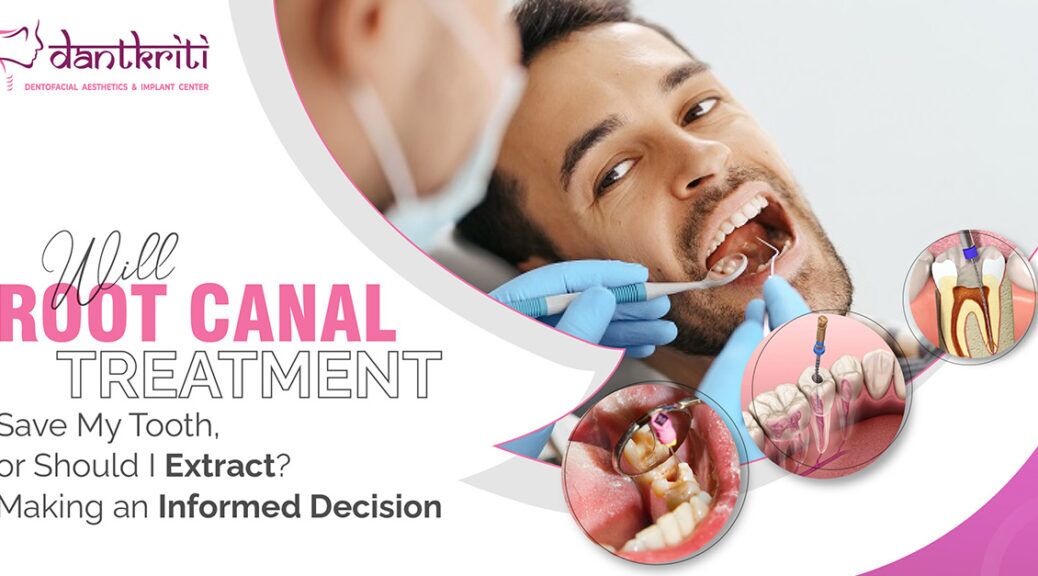
Will Root Canal Treatment Save My Tooth, or Should I Extract? Making an Informed Decision
When faced with a severely decayed or infected tooth, it’s natural to wonder whether a root canal treatment can save the tooth or if extraction is the better option.
Preserving Your Natural Tooth
One of the primary advantages of root canal treatment is that it allows you to preserve your natural tooth. While extraction may seem like a quick fix when a tooth can be saved, it’s important to remember that losing a tooth can significantly affect your oral health and overall well-being.
Maintaining Proper Dental Function: Your natural teeth are designed to work harmoniously to perform essential functions such as chewing and speaking. When extracted, a tooth can disrupt this balance, leading to difficulties with eating and speaking and the potential shifting of adjacent teeth.
Preventing Bone Loss: The underlying jawbone may deteriorate over time when a tooth is extracted. It occurs because the tooth’s roots are no longer present to stimulate the bone, leading to bone loss and potential changes in your facial structure. Root canal treatment prevents this bone loss by preserving natural teeth and roots.
Avoiding Tooth Replacement Options: Extracting a tooth necessitates considering tooth replacement options such as dental implants, bridges, or dentures. These options may involve additional procedures, cost, and time. You can avoid needing more extensive dental interventions by saving your natural tooth through root canal treatment.
The Root Canal Treatment Process
Root canal treatment involves several stages and is typically performed by a dental specialist with expertise in treating the tooth’s interior pulp and root canals. Here’s a breakdown of the root canal treatment process:
Diagnosis and Examination: The first step is a thorough examination by your dentist or endodontist. They will evaluate the tooth’s condition, take X-rays to assess the extent of infection or decay, and determine if root canal treatment is necessary.
Anesthesia and Isolation: Once it’s determined that root canal treatment is required, the affected tooth and the surrounding area will be numbed with a local anesthetic to ensure a comfortable procedure. A rubber or dental dam is placed around the tooth to isolate and keep it dry during the treatment.
Pulp Removal: An access opening is created on the tooth’s surface to reach the pulp chamber. The infected or inflamed pulp is carefully removed from the tooth and root canals using specialized instruments.
Cleaning and Shaping: After removing the pulp, the root canals are thoroughly cleaned, shaped, and disinfected. This process eliminates all bacteria, debris, and infected tissue, reducing the risk of further infection.
Filling and Sealing: Once the root canals are cleaned and shaped, they are filled with a biocompatible gutta-percha material.
Post-Treatment Care and Success Rates
Following a root canal treatment, it is essential to care for the treated tooth to ensure its long-term success.
Oral Hygiene: Maintain a rigorous oral hygiene routine by brushing your teeth at least twice daily and flossing daily. Use a soft-bristled toothbrush and fluoride toothpaste to clean the treated tooth and surrounding area gently. Additionally, rinse your mouth with an antimicrobial mouthwash to reduce the risk of infection.
Regular Dental Check-ups: Schedule regular follow-up visits with your dentist to monitor the progress of the treated tooth. X-rays may be taken periodically to assess the healing and ensure no signs of reinfection. Your dentist will also check the integrity of the restoration and make any necessary adjustments.
Avoid Chewing on Hard Foods: While the treated tooth should be fully functional, it is advisable to avoid chewing on extremely hard or sticky foods that could potentially damage the restoration or the tooth itself. Opt for softer foods and gradually reintroduce more complex textures as you feel comfortable.
Address Sensitivity or Discomfort: It is common to experience some sensitivity or discomfort in the treated tooth for a few days after the procedure. However, contact your dentist promptly if you experience persistent or severe pain, swelling, or other concerning symptoms.
The success rate of root canal treatment is generally high, with studies reporting success rates ranging from 85% to 97%. However, individual outcomes may vary depending on various factors, including the tooth’s condition before treatment, the skill of the dental professional, and patient compliance with post-treatment care.
Factors to Consider for Extraction
While root canal treatment is often recommended to save a tooth, there are instances where extraction may be a more suitable option. Your dentist may recommend tooth extraction if:
Severe Tooth Decay or Damage: Extraction may be necessary if the tooth is extensively decayed or damaged beyond repair. In such cases, the tooth may not be salvageable through root canal treatment.
Advanced Gum Disease: If gum disease has caused significant damage to the tooth’s supporting structures, extraction may be the most viable solution to prevent further complications and preserve oral health.
Wisdom Teeth: Most of the wisdom teeth or the third molars do not erupt in proper position in the jaw due to lack of space. Also there position and root anatomy make it a difficult choice for a proper root canal procedure and further restoration. Most of the time extraction is preferred over RCT in case of wisdom teeth
Consultation with a dental professional is crucial in determining the best course of action for your specific situation. They will evaluate the tooth’s condition, discuss the pros and cons of both options, and help you make an informed decision based on your oral health goals, preferences, and overall well-being.